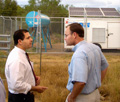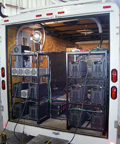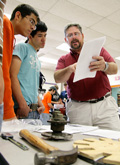
If Pete Lara goes to the La Presa colonia in Webb County, Texas at night, he’ll see that some of its homes are now lit with safe, reliable electricity. With his help, the rest of the colonia’s homes are on track to get electricity too.
Lara is the associate director for the central Rio Grande region of the Texas A&M College of Architecture’s Center for Housing and Urban Development, and he’s helped make CHUD instrumental in getting electricity into La Presa.
With the assistance of CHUD and a variety of project partners, residents in 12 homes in La Presa, a colonia five miles from Laredo’s city limits, are hooked up to a microgrid that provides electricity to their homes — the first phase of a pilot project that will eventually supply power to the entire La Presa community.
Colonias, such as La Presa, are housing developments on the United States side of the U.S.-Mexico border that often lack basic necessities such as electricity, water or sewer systems.
The idea for the electrification of La Presa grew out of a dilemma confronting Dub Taylor, director of the Texas State Energy Conservation Office (TSECO), according to a report published in the September/October 2007 issue of Distributed Energy. A Texas congressman had suggested installing of solar panels on the roofs of La Presa homes as a power source. But photovoltaic panels, Taylor soon learned, were easy targets for thieves. So, a solution was still needed.
Taylor took the problem to representatives for Xtreme Power, a Kyle, Texas power systems company, which suggested a microgrid they’d been working on for several years. A microgrid is a small system that provides electricity to a limited area without the need to use the interstate transmission system or the local grid.
Sold on the idea, TSECO enlisted the help of scientists from the Texas Engineering Experiment Station (TEES) to customize the mirogrid system for use in the colonias. The project was further advanced by a $200,000 state grant.
The effort resulted in a unique microgrid design for La Presa, which includes a generator that runs on biodiesel and is supplemented by solar panels and a wind turbine. It is capable of providing 12 homes with power around the clock.
The colonia residents, however, needed help implementing the technology, and that, Lara said, is where CHUD played an essential role.
“We are the link,” said Lara. “In La Presa we employ one person that knows all the people.”
That person, Angela Cruz, an AmeriCorp*Vista Volunteer, is providing face-to-face contact with residents and facilitating the efforts of Xtreme Power and TSECO. Provided to CHUD by the Corporation for National and Community Service, Cruz is also enrolled in the Certified Community Health Worker curriculum offered through the CHUD Academy.
Because many state laws regulate the generation and distribution of energy, the La Presa residence also needed legal help. To that end, CHUD enlisted the help of Weslaco-based Texas Legal Rural Aid, an organization that provides free civil legal assistance to eligible south and west Texans and eligible migrant and seasonal farm workers.
“Those folks are handling all the legal papers,” said Lara. “For instance, we needed permission to excavate and then lay the cable from the generator to the houses to install electric meters. Then we needed permission from another person to set the generator on their property.”
As the microgrids come online, La Presa residents set up accounts to purchase electricity.
“They can buy a block of power in advance so they don’t need to have credit extended to them,” said Dean Schneider, a TEES research engineer working on the project.
He said TEES is trying to determine if they “can reduce the cost and raise efficiency enough for it to make economic sense for someone to buy these systems and install them in a neighborhood that doesn’t have grid power or can’t get it because of various state laws and regulations.”
The emphasis is on temporary power in the La Presa project, said Schneider, because colonias lack plats, or survey maps. Without a plat, sewer and water connections can’t be made, and those are needed to establish a connection to a permanent power grid.
It’s far better to be part of a microgrid than to use a generator powered by gasoline, he added. “If you use a little gas generator you’re spending $2 to $3 for a kilowatt hour,” he said. “It’s a lot more economically feasible to have 24-hour power and pay 25 cents a kilowatt hour.” He said the various entities involved in the project are working to get the price of the energy under 25 cents a kilowatt hour.
CHUD is also helping TEES and the state’s energy conservation office with a project demonstrating how electricity is generated with wind turbines. Schneider and a group of fellow engineers have been teaching students at engineering magnet schools in Laredo about wind turbines since 2006.
“Their teachers are learning along with them,” said Schneider. “The students are creating a set of plans that will be translated into Spanish so local residents can use to build these turbines.”
Two turbines are currently in place at Cigarroa High School in Laredo and at the Webb County Self-Help Center. “At the end of the project we’ll have four of these turbines sitting out there and people can actually go see them operate,” said Schneider.
The College of Architecture's Colonias Program in the Center for Housing and Urban Development implements solutions that reduce the isolation of the impoverished residents of the colonias developments along the Texas-Mexico border and helps them become full participants in the U.S. economy and society.
For more information on CHUD, visit http://archone.tamu.edu/chud/.

A reception took place at Elario Martinez’ residence following a ceremony marking the connection of 12 La Presa homes to a microgrid; Martinez’ home is lit by power from the microgrid. Martinez is the president of the La Presa — Mangana-Hein Community Association.

Rep. Henry Cuellar, D-Laredo, left, visits with Dub Taylor, director of the Texas State Energy Conservation Office, before a ceremony that marked the connection of 12 homes in the La Presa colonia to the microgrid.

Workers lay electrical lines to colonia homes in trenches dug from the microgrid generator.

Electrical equipment to power homes in the microgrid is housed in a trailer in the La Presa colonia.

A load bank was used to test the microgrid generator.

Cigarroa High School students in Laredo raise an electricity-generating wind turbine they built in a project the College of Architecture’s Center for Housing Development helped facilitate.

Texas Engineering Experiment Station research engineer Dean Schneider discusses wind turbine design with students at Laredo United High School.

Students at United High School built wind turbines with the help of TEES visiting engineers. Here, a student weighs a stator coil, part of the turbine’s motor assembly, to verify the number of turns in the coil.

Students show off a completed wind turbine blade assembly.
